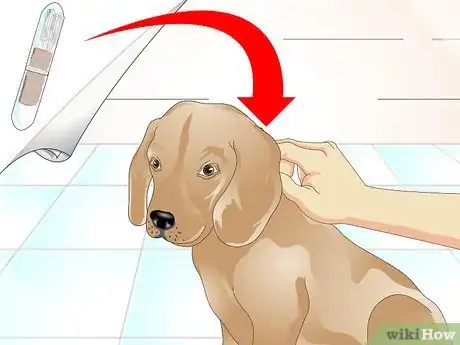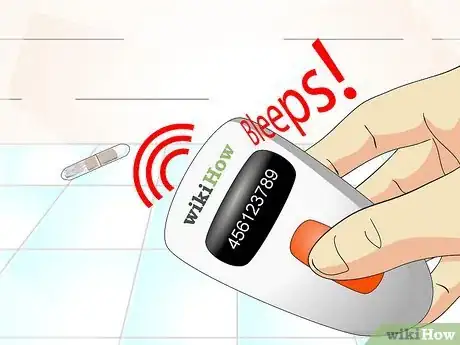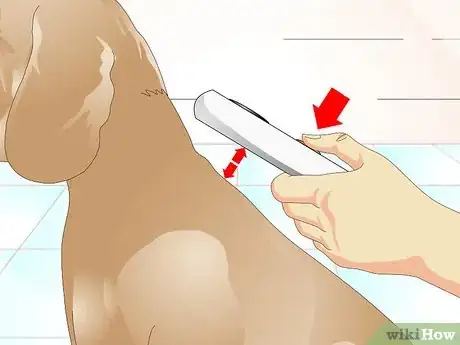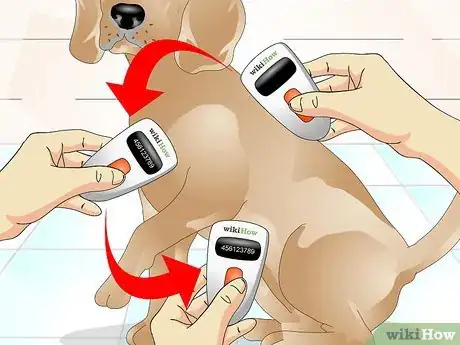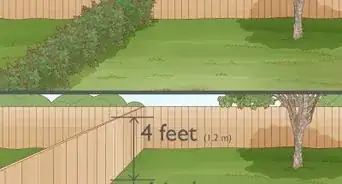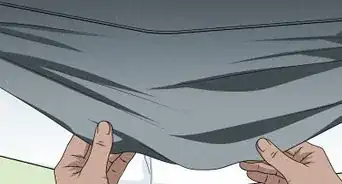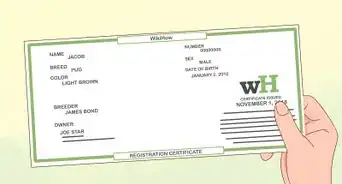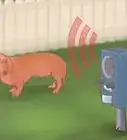This article was co-authored by Ray Spragley, DVM. Dr. Ray Spragley is a Doctor of Veterinary Medicine and the Owner/Founder of Zen Dog Veterinary Care PLLC in New York. With experience in multiple institutions and private practices, Dr. Spragley’s specializations and interests include non-surgical management of cranial cruciate ligament tears, Intervertebral Disk Disease(IVDD), and pain management in osteoarthritis. Dr. Spragley holds a BS in Biology from SUNY Albany and has a Doctor of Veterinary Medicine degree (DVM) from Ross University School of Veterinary Medicine. He is also a Certified Canine Rehabilitation Therapist (CCRT) through the Canine Rehab Institute as well as a Certified Veterinary Acupuncturist (CVA) through Chi University.
This article has been viewed 211,132 times.
Microchips placed in dogs are small passive radio emitters about the size of a grain of rice that are injected under the skin above the shoulder blades. Each microchip has a unique number, and that number is registered on an official central database along with a description of that dog, the owner's name, address, and contact phone numbers.[1] [2] When a scanner is passed over the microchip, that unique number is picked up and displayed on the scanner. Knowing if a dog has a microchip is especially helpful if you find a stray dog and need to trace the owner.[3]
Steps
Looking For a Microchip
-
1Look for a tag on the dog's collar. If the dog is wearing a collar take a look to see if it has a specific tag that says the dog is microchipped. Microchips are made by different manufacturers, and these companies usually issue a metal tags to place on the dog's collar to alert interested parties that the dog is chipped.[4]
- The tag is supplied in part to let anyone that finds a dog know that it is chipped in order to scan them but it is also a visual deterrent to potential thieves thinking of stealing the dog, since the dog has permanent ID as belonging to someone else.[5]
- If the dog does not have an official ID tag on their collar, look for a bespoke collar tag bearing wording such as "I am microchipped" or "microchipped." Know that this is not the same as a tag engraved with the dog's name and phone number. The purpose of this tag is purely to alert the finder that the dog is chipped and should be scanned. This type of tag usually does not carry personal details.
-
2Feel for the microchip. If the dog has lost their collar or there is no tag on the collar, try gently feeling for the presence of the microchip. The microchip is encased in a perspex coat that is the size and shape of a grain of rice. Microchips are injected under the skin in the loose skin of the neck at the centerline between the shoulder blades. Therefore this is the ideal place to start feeling.
- Run your fingertips over the skin between the shoulder blades and neck. Apply gentle pressure to see if you can detect a firm rice-grain sized object just under the skin. Microchips do bed in, which means they can migrate slightly from the original implant site.
- To reduce the chance of missing a microchip, work in a methodical manner working up and down between shoulder and head and then left to right working side to side from the shoulders up the neck until every inch is covered.
- This is not a foolproof method. If you can't feel a chip it does not mean the dog is definitely not chipped because the chip may be present but have shifted location or is embedded too deeply to feel.
Advertisement -
3Get a definitive answer by getting the dog scanned. Even if the dog doesn't have a tag that says it has a chip and you don't feel one, it's best to scan the dog to find out. It is worth scanning for a microchip if you are trying to get the contact details of a lost dog's owner.[6]
-
4X-ray the dog. Microchips show up on x-ray. While this is not routinely used as a method to check if a chip is present, in cases where a chip was implanted and has stopped working, taking a radiograph of the dog is a quick and easy way to check the chip is still in place but not working.
Scanning For a Microchip
-
1Check the scanner. First, the operator needs to check that the scanner is working by pressing the 'on' button and passing the sensor over a test chip. If the scanner bleeps and displays a number it is working. If the batteries are dead the display will either remain blank or display a message "low battery."
- If the scanner is working but has not scanned a microchip after a set period of time it displays the message "no chip found."
-
2Scan the dog's shoulders. Turn on the scanner and hold it one inch above the skin. Move the scanner in up and down sweeps from the shoulder to neck and then from side to side. When the scanner activates, make a note of the number.
-
3Check other places on the dog's body. If no chip is found with a methodical scanning pattern over the shoulders, don't give up. Pass the scanner over the remainder of the body. This includes under the sternum and around the armpits, just in case it has migrated to an unusual location.
Expert Q&A
-
QuestionCan I use my phone as a microchip scanner?
 Ray Spragley, DVMDr. Ray Spragley is a Doctor of Veterinary Medicine and the Owner/Founder of Zen Dog Veterinary Care PLLC in New York. With experience in multiple institutions and private practices, Dr. Spragley’s specializations and interests include non-surgical management of cranial cruciate ligament tears, Intervertebral Disk Disease(IVDD), and pain management in osteoarthritis. Dr. Spragley holds a BS in Biology from SUNY Albany and has a Doctor of Veterinary Medicine degree (DVM) from Ross University School of Veterinary Medicine. He is also a Certified Canine Rehabilitation Therapist (CCRT) through the Canine Rehab Institute as well as a Certified Veterinary Acupuncturist (CVA) through Chi University.
Ray Spragley, DVMDr. Ray Spragley is a Doctor of Veterinary Medicine and the Owner/Founder of Zen Dog Veterinary Care PLLC in New York. With experience in multiple institutions and private practices, Dr. Spragley’s specializations and interests include non-surgical management of cranial cruciate ligament tears, Intervertebral Disk Disease(IVDD), and pain management in osteoarthritis. Dr. Spragley holds a BS in Biology from SUNY Albany and has a Doctor of Veterinary Medicine degree (DVM) from Ross University School of Veterinary Medicine. He is also a Certified Canine Rehabilitation Therapist (CCRT) through the Canine Rehab Institute as well as a Certified Veterinary Acupuncturist (CVA) through Chi University.
Veterinarian Microchips use NFC (Near Frequency Communication) technology and cannot be checked with a phone. Instead, you'll need a special chip reader to find the number.
Microchips use NFC (Near Frequency Communication) technology and cannot be checked with a phone. Instead, you'll need a special chip reader to find the number. -
QuestionWhat do you do when you find a lost dog?
 Ray Spragley, DVMDr. Ray Spragley is a Doctor of Veterinary Medicine and the Owner/Founder of Zen Dog Veterinary Care PLLC in New York. With experience in multiple institutions and private practices, Dr. Spragley’s specializations and interests include non-surgical management of cranial cruciate ligament tears, Intervertebral Disk Disease(IVDD), and pain management in osteoarthritis. Dr. Spragley holds a BS in Biology from SUNY Albany and has a Doctor of Veterinary Medicine degree (DVM) from Ross University School of Veterinary Medicine. He is also a Certified Canine Rehabilitation Therapist (CCRT) through the Canine Rehab Institute as well as a Certified Veterinary Acupuncturist (CVA) through Chi University.
Ray Spragley, DVMDr. Ray Spragley is a Doctor of Veterinary Medicine and the Owner/Founder of Zen Dog Veterinary Care PLLC in New York. With experience in multiple institutions and private practices, Dr. Spragley’s specializations and interests include non-surgical management of cranial cruciate ligament tears, Intervertebral Disk Disease(IVDD), and pain management in osteoarthritis. Dr. Spragley holds a BS in Biology from SUNY Albany and has a Doctor of Veterinary Medicine degree (DVM) from Ross University School of Veterinary Medicine. He is also a Certified Canine Rehabilitation Therapist (CCRT) through the Canine Rehab Institute as well as a Certified Veterinary Acupuncturist (CVA) through Chi University.
Veterinarian Take the lost dog to a local veterinarian and find out the microchip number. This number should be registered to the owner, and their information should be accessible once you acquire it.
Take the lost dog to a local veterinarian and find out the microchip number. This number should be registered to the owner, and their information should be accessible once you acquire it.
References
- ↑ https://www.petfinder.com/dogs/lost-and-found-dogs/how-pet-microchips-work/
- ↑ Ray Spragley, DVM. Veterinarian. Expert Interview. 29 June 2021.
- ↑ http://www.rspca.org.uk/adviceandwelfare/pets/general/microchipping
- ↑ http://www.rspca.org.uk/adviceandwelfare/pets/general/microchipping
- ↑ http://www.rspca.org.uk/adviceandwelfare/pets/general/microchipping
- ↑ Ray Spragley, DVM. Veterinarian. Expert Interview. 29 June 2021.
About This Article
To tell if a dog is microchipped, gently feel the dog’s skin between its shoulder blades and its neck. See if you can feel a small, hard object about the size of a grain of rice just beneath the skin. If so, the dog is microchipped. If you can’t feel a chip, however, the dog may still have one. The chip may have shifted location or have become embedded too deeply to feel. In this case, you will need to use a microchip scanner to locate the chip. For tips from our veterinary reviewer on using a microchip scanner, read on!


